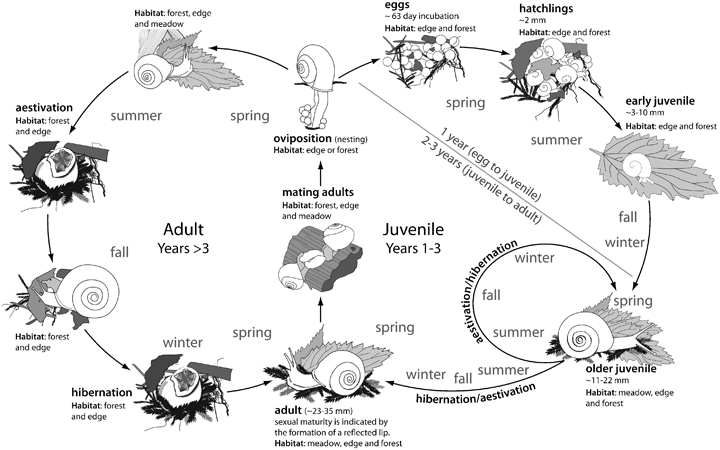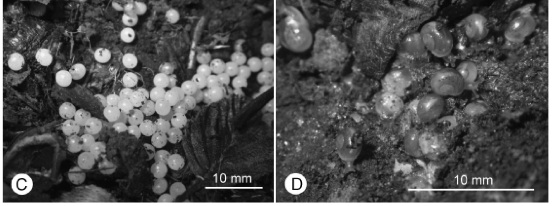Reproduction
This is a diagram of the life cycle of Allogona townsendiana, which can be assumed to be very similar to that of Allogona profunda.
The reproduction of Allogona profunda (Say) is very different
from a lot of other types of land snails. First of all, the genital organs
begin to evert as soon as the animals are in contact with one another. The
protrusion of the sex organs is complete specifically relies on the behavior
of the snails (Webb, 1948).
The courtship then continues with biting duels. It begins when one animal
protrudes its jaw and radula forward as much as it can and then bites its
mate on the head. The other animal may cringe and turn back by rotating or
it may just move its foreparts to launch a counter-attack. The purpose for
these aggressive actions is to simulate an increase in the protrusion of the
sex organs (Webb, 1948).
Once the protruded penis is touched against the other animal’s organ,
complete eversion and protrusion follows and coitus begins. At the same time
as this is occurring, the biting stops and the snails start to gnaw on these
organs (Webb, 1948).
Coitus lasts for a long time. In one study, two snails were examined to
begin coitus at 9:45pm and were last seen in coitus at 10:15am the next
morning (Webb, 1948).
The female sex organ is a large tubular body and is differentiated into two
parts: the minutely and transversely-rugose basal part and a smoother more
tumid terminal part (Webb, 1948).
The male’s penis, which is said to resemble a flagellate grape, is large,
tumid, and ovoid. It also bears the simulator, an acuminate flap-like
structure, and below that a large orifice opens into the cavernous interior
of the penis. The female organ is normally found resting in this cavity.
Also, the ejaculatory pore is located at the tip of a small papilla on the
innermost wall of the penis cavity. Some research suggests that the papilla
may be inserted into the orifice at the tip of the female organ during
coitus (Webb, 1948).
From research done on Allogona townsendiana, hatching of the eggs
after oviposition occurred after about 63 to 64 days. And within hours of
hatching the new juveniles were dispersing from the nesting site. By around
one month almost all had completely dispersed (Steensma, 2009). This
research can be applied to Allogona profunda (Say) because these
two snails are from the same genus and have similar characteristics.
The picture on the left shows eggs of Allogona townsendiana after oviposition and the picture on the right shows juvenile Allogona townsendiana snails after hatching.
Allogona profunda (Say) is reported to remain in the juvenile stage
for about two winters and also that a life span of four years was documented
(Blinn, 1963).

